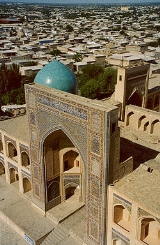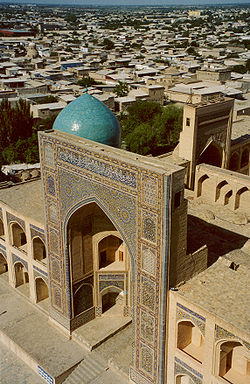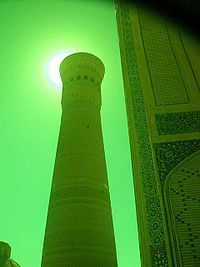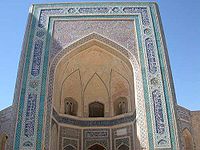
Po-i-Kalyan
Encyclopedia

Kalyan minaret
The Kalyan minaret is a minaret of the Po-i-Kalyan mosque complex in Bukhara, Uzbekistan and one of the most prominent landmarks in the city.The minaret, designed by Bako, was built by the Qarakhanid ruler Arslan Khan in 1127 to summon Muslims to prayer five times a day...
in Bukhara
Bukhara
Bukhara , from the Soghdian βuxārak , is the capital of the Bukhara Province of Uzbekistan. The nation's fifth-largest city, it has a population of 263,400 . The region around Bukhara has been inhabited for at least five millennia, and the city has existed for half that time...
, Uzbekistan.
History

Genghis Khan
Genghis Khan , born Temujin and occasionally known by his temple name Taizu , was the founder and Great Khan of the Mongol Empire, which became the largest contiguous empire in history after his death....
during the siege of Bukhara, was built in 1121 by the Karakhanid ruler Arslan-khan. The Minaret Kalyan is the only of structures of Arslan-han complex, which was kept safe during that siege.
Architectural features


Kalyan Mosque
Kalyan Mosque (Maedjid-i kalyan), arguably completed in 1514, is equal with Bibi-Khanym MosqueBibi-Khanym Mosque
Bibi-Khanym Mosque is a famous historical Friday mosque in Samarkand, Uzbekistan, whose name comes from the wife of 14th-century ruler, Amir Timur.-Features:...
in Samarkand in size. Although they are of the same type of building, they are absolutely different in terms of art of building. The roofing (of 288 domes) of the galleries encircling the courtyard of Kalyan Mosque rests on 208 pillars. The courtyard ends up with a portal to the main chamber with a cruciform hall, topped with a massive blue cupola on a mosaic drum.
Mir-i Arab Madrasah
There is little known about the Mir-i Arab Madrasah origin. The construction of Mir-i-Arab Madrasah is ascribed to Sheikh Abdullah Yamani of Yemen, the spiritual mentor of early ShaybanidsMuhammad Shaybani
Abu 'I-Fath Muhammad , known in later centuries as Shaybani Khan , was a khan of the Uzbeks who continued consolidating various Uzbek tribes and laid foundations for their ascendance in Transoxiana. of Genghis Khan through his grandson Shayban and considered the Timurids as usurpers of the...
. He disputably was in charge of donations of Abdullah-khan (1512-1533), devoted to construction of religion edifice.

